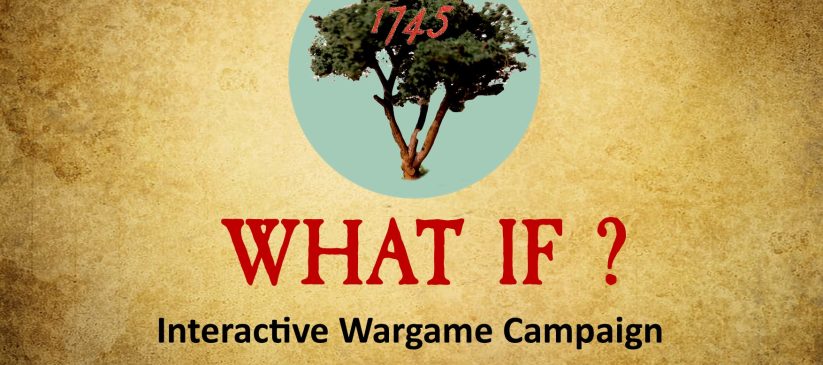
Our counter-factual campaign game is now underway (21/01/23), giving our Facebook followers the chance to direct the Jacobite army’s operations in the aftermath of the victory at Battle of Prestonpans. The remnants of Sir John Cope’s army have assembled at Berwick-upon-Tweed, and there are still British garrisons in the Highlands and in Edinburgh and Stirling castles; but there is no field army to oppose the Jacobite army’s immediate options.
FIRST JACOBITE DECISION
The public were invited to vote on the following strategic options:
A) Consolidate in Edinburgh, allowing word of the victory to encourage recruitment, whilst placing Edinburgh Castle under blockade.
B) March immediately to the walled town of Berwick-upon-Tweed, securing a bridgehead into England in the east.
C) March immediately on Carlisle, to secure a bridgehead into England in the west.
D) Divert strength northwards to challenge the British army’s remaining outposts in Scotland.
The public decision chose Option A, following the historical course. This leads to the Prince establishing himself at Holyroodhouse whilst he awaits reinforcements from the north. Edinburgh Castle, a formidable obstacle, remains in enemy hands and the Jacobites lack the heavy siege guns needed to batter it into submission. For the moment, a blockade is established to prevent the garrison resupplying.
FIRST BRITISH ARMY DECISION
Meanwhile, defeat at Prestonpans means there’s no available British field army in Scotland. There are however garrisons across the Highlands (Forts George, Augustus, and William), and two substantial castles at Stirling and Edinburgh. The remnants of Cope’s army are at Berwick-upon-Tweed, and small militia garrisons are gathering at Newcastle and Carlisle. King George II has recently returned from Europe to deal with the emergency, and has ordered a strong army to be assembled in England – but that will take time.
The first British army decision was to either:
A) Maintain the current position whilst waiting for Marshal Wade’s army to assemble.
B) Withdraw the garrison at Berwick to Newcastle
C) Withdraw the garrison at Berwick to Carlisle
The decision was taken, by the narrowest possible margin, to withdraw the soldiers at Berwick-upon-Tweed south to the economically significant city of Newcastle. This is a journey of 65 miles, and will commence after the arrival of a Dutch regiment which is expected at Berwick imminently. The Earl of Loudoun has been sent to Inverness to rally the loyal clans and potentially disrupt Jacobite recruitment in the north.
Both factions now have the opportunity to strengthen their positions, so let’s explain how recruitment works for the game.
RECRUITMENT IN SCOTLAND
For the purposes of the game, Scotland is divided into two regions: Highland and Lowland. If there is a suitable officer designated to command them, recruits can be raised in each. Monthly dice rolls (arranged by the Gamemaster) will determine the level of successful recruitment in each region for each force. A force occupying the capital can also roll once for recruitment during its time in occupation.
New regiments will must march to their regional rendezvous, moving in real time according to a table of marching speeds affected by the time of year. During their march they can use initiative to intercept enemy units, or can themselves be intercepted.
When a new regiment reaches its regional commander, to reflect the semi-autonomous nature of these officers, a dice roll determines how he choses to use them: sending them on the main army, using them to control local strategic points, or retaining them himself to build a secondary force. This secondary force can then be ordered around directly by public voting decisions.
In this first phase of the campaign, the Jacobites have left Tullibardine (the Jacobite duke of Atholl) to coordinate recruitment in the north. He is based at Blair Castle.
The British army is sending the Earl of Loudoun, who escaped from the battle at Prestonpans, to oversee the raising of new Highland companies in the north. They are relying on the Duke of Argyll to coordinate recruitment in the south, where he can raise his own clan and urban militia from Glasgow and Edinburgh. The latter two can only recruit if the Jacobites are not within a day’s march of those towns.
If the Jacobites successfully eradicate all of the British army’s garrisons in Scotland, the government will be unable to continue recruiting and equipping fresh forces there.
INTERCEPTIONS
If a force moves within 20 miles of a garrison or other enemy position, then a dice roll will determine whether there is an attempt to intercept or confront the enemy. The outcome might trigger a retreat, a diversion, or an engagement which needs to be fought on the tabletop.
These small actions can have unexpetedly important consquences: garrisons can be severely weakened, reinforcements might be prevented reaching other forces, or naval landings can be denied by the presence of hostile troops.
You can keep up to date on the campaign at our museum, where all the data on the armies and their progress is collated:
